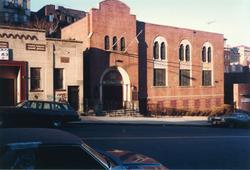| Synagogue | Organized | Dedicated |
|---|---|---|
| Sephardic Jewish Center | 1946 |
| Non-Synagogue | Type |
|---|---|
| Walker Memorial Baptist Church | church |
116
East 169
at
Walton
Bronx, NY 10452
The building is currently a church.

small - medium - large - full
Personal Impressions
1 | 2 | 3 | 4 | 5 | 6 | 7 | 8 | 9I once attended an affair at the Sephardic Jewish Center. The older people, mostly from Greece and Turkey, spoke an archaic Spanish called Ladino and to my surprise I could converse with them in modern Spanish which I knew very well.
I remember the choir sneaking out and going to lunch on Yom Kippur.
The rabbi was Rabbi Murciano when I attended. He's now in Forest Hills.
I once went to a funeral in an Orthodox synagogue. Someone told me,Don't bring
flowers
.
We named our children after living relatives while the Orthodox named their children after dead ones. When I married an Ashkenazi Jew, I went with his tradition and named our children after dead people.
Edie Gorme's mother was a member of the Sephardic Temple. Edie Gorme entertained us at a luncheon.
The first rabbi was Rabbi Cardoza.
Halfway down the hill on 169th Street was a small shul. I quizzed my father about the
shul and why we never attended services there. He replied that they were strange people.
Only after I became an adult did I realize that the strange people
were Sephardic Jews.
Our family were members of the Sephardic Temple on 169th Street. In fact, the original rabbi - Rabbi Marciano - is still practicing with the Sephardic Temple in Forest Hills.
Possibly, the most vivid memory is of the high holy days. How, as kids, we could not wait to get out of temple in order to walk down to Joyce Kilmer Park on 161st Street to socialize with our friends. On a sunny holiday there would be a thousand kids in the park, all wearing their best clothes.
Another memory is of passing the 167th Street Cafeteria on the holidays and seeing it packed with Jewish people who were taking a break from temple.
The Sephardic Jewish Center was an Orthodox synagogue, associated with the Union of
Orthodox Congregations. The synagogue had 1,000 members, mostly of Greek and Turkish
origin. The congregants ranged in their ritual observance and the synagogue tolerated
and respected the entire spectrum of personal practice. The congregation permitted the
use of microphones turned on before the Sabbath, and had separate seating for men and
women but no physical mehitza
or barrier between the men and women's sections.
Rabbi Murciano gave a sermon in English every Shabbat. There was also a daily minyon. On Rosh Hashona and Yom Kippur, a special balcony had to be constructed every year to accommodate an overflow crowd, in addition to concurrent services conducted in their auditorium downstairs.
The congregation now exists as the Sephardic Jewish Center of Forest Hills. Rabbi Murciano was given a 40th testimonial dinner by the congregation in 1993.
One memory was passing the 167th Street Cafeteria on the holidays and seeing it packed with Jewish people who were taking a break from temple.
We attended the Sephardic Jewish Center on East 169th from the late 1940s till my mom finally moved in the later 1970s. Prior to that, the family attended the Sephardic synagogue on Morris off of 170th. Rabbi Murciano taught me my Bar Mitzvah lessons. The last time I saw him was several years ago at my mother's funeral. As far as I know, he's still going strong as the Rabbi at the Forest Hills Sephardic synagogue on 108th Street. Our synagogue produced one of the world's greatest concert pianists - Murray Perahia. As a young child, he often played piano at various synagogue functions, showing signs of the greatness to follow. His family was very prominent in the Sephardic community.
I would like to correct one comment below the picture of our synagogue. Someone stated that "a special balcony had to be constructed every year to accommodate an overflow crowd" for Rosh Hashona and Yom Kippur. Not so. The balcony was a permanent structure and was one of two sections set aside for women, the other being on the left side of the main sanctuary. During the High Holidays, we always attended services in the auditorium sanctuary downstairs - the tickets were cheaper!

